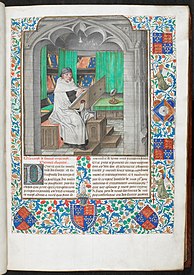Text (literary theory)
In literary theory, a text is any object that can be "read", whether this object is a work of literature, a street sign, an arrangement of buildings on a city block, or styles of clothing.[citation needed] It is a set of signs that is available to be reconstructed by a reader (or observer) if sufficient interpretants are available.[citation needed] This set of signs is considered in terms of the informative message's content, rather than in terms of its physical form or the medium in which it is represented.[citation needed]
Within the field of literary criticism, "text" also refers to the original information content of a particular piece of writing; that is, the "text" of a work is that primal symbolic arrangement of letters as originally composed, apart from later alterations, deterioration, commentary, translations, paratext, etc. Therefore, when literary criticism is concerned with the determination of a "text", it is concerned with the distinguishing of the original information content from whatever has been added to or subtracted from that content as it appears in a given textual document (that is, a physical representation of text).
Since the history of writing predates the concept of the "text", most texts were not written with this concept in mind. Most written works fall within a narrow range of the types described by text theory. The concept of "text" becomes relevant if and when a "coherent written message is completed and needs to be referred to independently of the circumstances in which it was created."[citation needed]
Etymology
[edit]The word text has its origins in Quintilian's Institutio Oratoria, with the statement that "after you have chosen your words, they must be weaved together into a fine and delicate fabric", with the Latin for fabric being textum.
Uses of the term for analysis of work practice
[edit]Relying on literary theory, the notion of text has been used to analyse contemporary work practices. For example, Christensen (2016)[1] rely on the concept of text for the analysis of work practice at a hospital.
See also
[edit]References
[edit]- ^ Christensen, L.R. (2016). On Intertext in Chemotherapy: an Ethnography of Text in Medical Practice. Computer Supported Cooperative Work (CSCW): The Journal of Collaborative Computing and Work Practices. Volume 25, Issue 1, pp 1-38
Further reading
[edit]- Barry, Peter. Beginning Theory: an Introduction to Literary and Cultural Theory, 4th edn. Manchester: Manchester University Press, 2017. ISBN 0-7190-6268-3.
- Bakhtin, M. M. (1981) The Dialogic Imagination: Four Essays. Ed. Michael Holquist. Trans. Caryl Emerson and Michael Holquist. Austin and London: University of Texas Press.
- Culler, Jonathan; (1997) Literary Theory: a Very Short Introduction. Oxford: Oxford University Press. ISBN 0-19-285383-X.
- Eagleton, Terry. Literary Theory: an Introduction, 2nd edn. Hoboken: John Wiley & Sons, 2011. ISBN 0-8166-1251-X.
- Eagleton, Terry. After Theory. NY: Basic Books, 2003. ISBN 0-465-01773-8.
- Groden, Michael, Martin Kreiswirth, & Imre Szeman, eds. The Johns Hopkins Guide to Literary Theory and Criticism, 2nd edn. Baltimore: Johns Hopkins University Press, 2005. ISBN 0-8018-4560-2.
- Lodge, David and Nigel Wood, eds. Modern Criticism and Theory: a Reader, 3rd edn. Harlow: Pearson Longman, 2008.
- Patai, Daphne and Wilfrido H. Corral, eds. Theory's Empire: an Anthology of Dissent. NY: Columbia University Press, 2005. ISBN 0-231-13417-7.
- Rabaté, Jean-Michel. The Future of Theory. Oxford: Blackwell, 2002. ISBN 0-631-23013-0.






